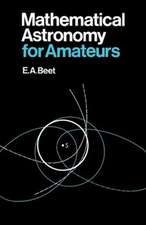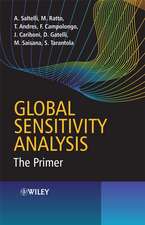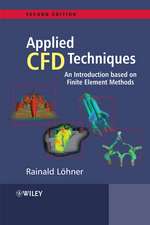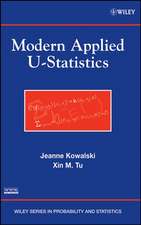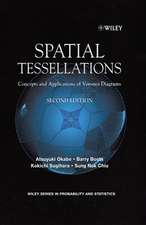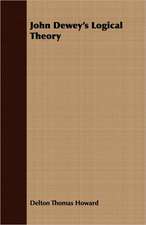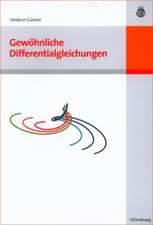Basics of Ramsey Theory
Autor Veselin Jungićen Limba Engleză Hardback – 9 iun 2023
Features
- Suitable for any undergraduate student who has successfully completed the standard calculus sequence of courses and a standard first (or second) year linear algebra course
- Filled with visual proofs of fundamental theorems
- Contains numerous exercises (with their solutions) accessible to undergraduate students
- Serves as both a textbook or as a supplementary text in an elective course in combinatorics and aimed at a diverse group of students interested in mathematics
Preț: 695.49 lei
Preț vechi: 764.27 lei
-9% Nou
Puncte Express: 1043
Preț estimativ în valută:
133.08€ • 139.30$ • 110.77£
133.08€ • 139.30$ • 110.77£
Carte disponibilă
Livrare economică 10-24 martie
Livrare express 22-28 februarie pentru 32.71 lei
Preluare comenzi: 021 569.72.76
Specificații
ISBN-13: 9781032260372
ISBN-10: 1032260378
Pagini: 238
Ilustrații: 2 Tables, black and white; 199 Line drawings, color; 199 Illustrations, color
Dimensiuni: 156 x 234 x 18 mm
Greutate: 0.51 kg
Ediția:1
Editura: CRC Press
Colecția Chapman and Hall/CRC
ISBN-10: 1032260378
Pagini: 238
Ilustrații: 2 Tables, black and white; 199 Line drawings, color; 199 Illustrations, color
Dimensiuni: 156 x 234 x 18 mm
Greutate: 0.51 kg
Ediția:1
Editura: CRC Press
Colecția Chapman and Hall/CRC
Public țintă
AcademicCuprins
1. Introduction: Pioneers and Trailblazers. 1.1. Complete Disorder is Impossible. 1.2 Paul Erdős. 1.3. Frank Plumpton Ramsey. 1.4 Ramsey Theory. 2. Ramsey’s Theorem. 2.1. The Pigeonhole Principle. 2.2. Acquaintances and Strangers. 2.3. Ramsey’s Theorem for Graphs. 2.4. Ramsey’s Theorem: Infinite Case. 2.5. Ramsey’s Theorem: General Case. 2.6. Exercises. 3. van der Waerden’s Theorem. 3.1. Bartel van der Waerden. 3.2. van der Waerden’s Theorem: 3–Term Arithmetic Progressions. 3.3. Proof of van der Waerden’s Theorem. 3.4. van der Waerden’s Theorem: How Far and Where? 3.5. van der Waerden’s Theorem: Some Related Questions. 3.6. Exercises. 4. Schur’s Theorem and Rado’s Theorem. 4.1 Issai Schur. 4.2. Schur’s Theorem. 4.3. Richard Rado. 4.4 Rado’s Theorem. 4.5. Exercises. 5. The Hales–Jewett Theorem. 5.1. Combinatorial Lines. 5.2. Generalized Tic–Tac–Toe Game. 5.3. The Hales–Jewett Theorem. 5.4. Exercises. 6. Happy End Problem. 6.1. The Happy End Problem: Triangles, Quadrilaterals, and Pentagons. 6.2. The Happy End Problem – General Case. 6.3. Erdős–Szekeres’ Upper and Lower Bounds. 6.4. Progress on the Conjecture OF Erdős and Szekeres. 6.5. Exercises. 7. Solutions.
Notă biografică
Dr. Veselin Jungić is a Teaching Professor at the Department of Mathematics, Simon Fraser University, Burnaby, British Columbia, Canada.
Dr. Jungić is a 3M National Teaching Fellow and a Fellow of the Canadian Mathematical Society. He is a recipient of several teaching awards. Veselin is one of only a few Canadian mathematicians who has been awarded both the Canadian Mathematical Society Pouliot Award (2020) and the Canadian Mathematical Society Teaching Award (2012).
Dr. Jungić’s publications range from education related opinion pieces to articles based on his teaching practices to Ramsey theory research and outreach papers.
One of Dr. Jungić’s accomplishments is the creation of the Math Catcher Outreach Program. Since the early 2010s, the Program has visited hundreds of classrooms, from kindergarten to grade 12, and created learning resources in multiple Indigenous languages. As an invited speaker, Veselin delivered several dozens of the Math Catcher–related workshops and lectures to teachers, academics, and public at the local, national, and international levels.
Dr. Jungić is a 3M National Teaching Fellow and a Fellow of the Canadian Mathematical Society. He is a recipient of several teaching awards. Veselin is one of only a few Canadian mathematicians who has been awarded both the Canadian Mathematical Society Pouliot Award (2020) and the Canadian Mathematical Society Teaching Award (2012).
Dr. Jungić’s publications range from education related opinion pieces to articles based on his teaching practices to Ramsey theory research and outreach papers.
One of Dr. Jungić’s accomplishments is the creation of the Math Catcher Outreach Program. Since the early 2010s, the Program has visited hundreds of classrooms, from kindergarten to grade 12, and created learning resources in multiple Indigenous languages. As an invited speaker, Veselin delivered several dozens of the Math Catcher–related workshops and lectures to teachers, academics, and public at the local, national, and international levels.
Descriere
This book serves as a gentle introduction to Ramsey theory for students interested in becoming familiar with a dynamic segment of contemporary mathematics that combines ideas from number theory and combinatorics. The core of the of the book consists of discussions and proofs of the results now universally known as Ramsey’s theorem.

